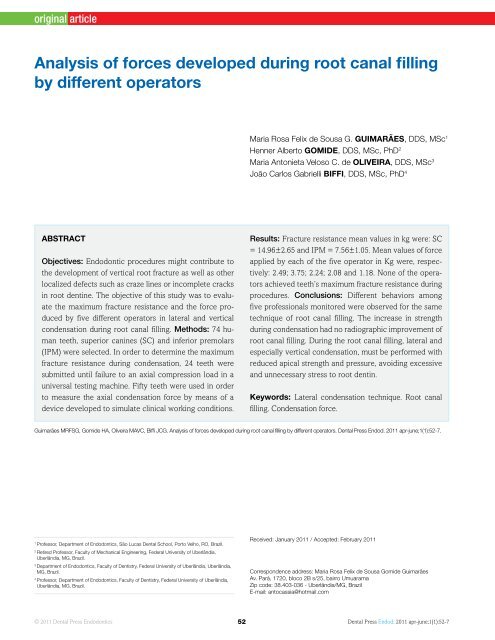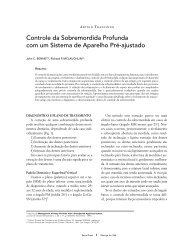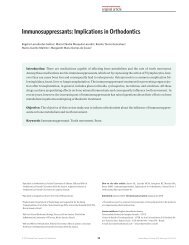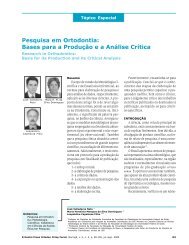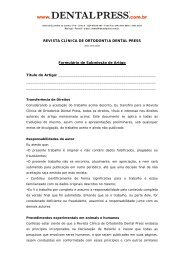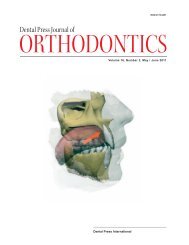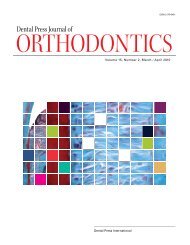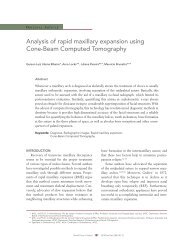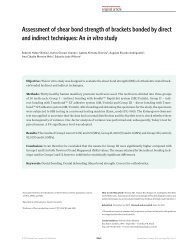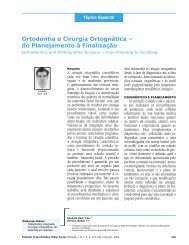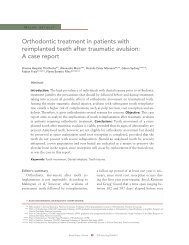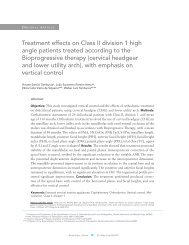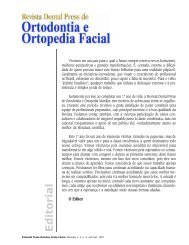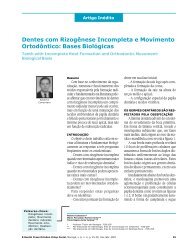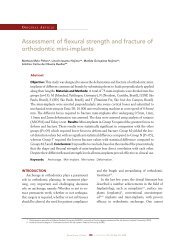Dental Press
Dental Press
Dental Press
Create successful ePaper yourself
Turn your PDF publications into a flip-book with our unique Google optimized e-Paper software.
original article<br />
Analysis of forces developed during root canal filling<br />
by different operators<br />
Maria Rosa Felix de Sousa G. GUIMARÃES, DDS, MSc 1<br />
Henner Alberto GOMIDE, DDS, MSc, PhD 2<br />
Maria Antonieta Veloso C. de OLIVEIRA, DDS, MSc 3<br />
João Carlos Gabrielli BIFFI, DDS, MSc, PhD 4<br />
Abstract<br />
Objectives: Endodontic procedures might contribute to<br />
the development of vertical root fracture as well as other<br />
localized defects such as craze lines or incomplete cracks<br />
in root dentine. The objective of this study was to evaluate<br />
the maximum fracture resistance and the force produced<br />
by five different operators in lateral and vertical<br />
condensation during root canal filling. Methods: 74 human<br />
teeth, superior canines (SC) and inferior premolars<br />
(IPM) were selected. In order to determine the maximum<br />
fracture resistance during condensation, 24 teeth were<br />
submitted until failure to an axial compression load in a<br />
universal testing machine. Fifty teeth were used in order<br />
to measure the axial condensation force by means of a<br />
device developed to simulate clinical working conditions.<br />
Results: Fracture resistance mean values in kg were: SC<br />
= 14.96±2.65 and IPM = 7.56±1.05. Mean values of force<br />
applied by each of the five operator in Kg were, respectively:<br />
2.49; 3.75; 2.24; 2.08 and 1.18. None of the operators<br />
achieved teeth’s maximum fracture resistance during<br />
procedures. Conclusions: Different behaviors among<br />
five professionals monitored were observed for the same<br />
technique of root canal filling. The increase in strength<br />
during condensation had no radiographic improvement of<br />
root canal filling. During the root canal filling, lateral and<br />
especially vertical condensation, must be performed with<br />
reduced apical strength and pressure, avoiding excessive<br />
and unnecessary stress to root dentin.<br />
Keywords: Lateral condensation technique. Root canal<br />
filling. Condensation force.<br />
Guimarães MRFSG, Gomide HA, Oliveira MAVC, Biffi JCG. Analysis of forces developed during root canal filling by different operators. <strong>Dental</strong> <strong>Press</strong> Endod. 2011 apr-june;1(1):52-7.<br />
1<br />
Professor, Department of Endodontics, São Lucas <strong>Dental</strong> School, Porto Velho, RO, Brazil.<br />
2<br />
Retired Professor, Faculty of Mechanical Engineering, Federal University of Uberlândia,<br />
Uberlândia, MG, Brazil.<br />
3<br />
Department of Endodontics, Faculty of Dentistry, Federal University of Uberlândia, Uberlândia,<br />
MG, Brazil.<br />
4<br />
Professor, Department of Endodontics, Faculty of Dentistry, Federal University of Uberlândia,<br />
Uberlândia, MG, Brazil.<br />
Received: January 2011 / Accepted: February 2011<br />
Correspondence address: Maria Rosa Felix de Sousa Gomide Guimarães<br />
Av. Pará, 1720, bloco 2B s/25, bairro Umuarama<br />
Zip code: 38.403-036 - Uberlândia/MG, Brazil<br />
E-mail: antocassia@hotmail.com<br />
© 2011 <strong>Dental</strong> <strong>Press</strong> Endodontics 52 <strong>Dental</strong> <strong>Press</strong> Endod. 2011 apr-june;1(1):52-7


